Now that your starter is bubbling away and you’ve learned how to write a recipe, let’s rest and take a day to practice some Baker’s Math. The answers and detailed explanations are at the bottom, so print out the worksheet, grab a pencil and a calculator, and see what you can figure out.
Inspired by practice problems from the Wild Yeast blog.
Problems
1. Convert each recipe to mass
A. Focaccia with 550 g Flour
100% Flour
73% Starter
86% Water
10 % Olive oil
1 % Salt
B. Pain Au Levain with 27 oz White Flour
100% White flour
50% Levain
67% Water
3% Salt
C. Olive Tartine with 800g Total Flour
80% White flour
20% Whole wheat flour
25% Levain
2% Salt
78% Water
40% Olives
1% Herbs de Provence
2. Convert each recipe to baker’s math
A. Cranberry Walnut Boule
700 g All-purpose flour
525 g Water
150 g Starter
90 g Walnuts
80 g Dried Cranberries
B. Bagels
12.3 oz High-gluten flour
4.3 oz Water
1 oz Milk powder
.6 oz Malt powder
.4 oz Salt
10.6 oz Starter
C. Pizza
285 g White flour
32 g Whole wheat flour
212 g Water
9 g Salt
47 g Starter
3. How much of each ingredient would you use to make:
A. 900 of dough
100% Bread flour
86% Water
2% Salt
14% Levain
B. 1050 g of dough
83% All-purpose flour
17% Whole wheat flour
22% Levain
79% Water
2.5% Salt
16% Sunflower seeds
4. How much dough can you make with the following restricted ingredients? How much of each ingredient would you use?
A. You only have 30g of milk left in your fridge
70% Whole wheat flour
30% All-purpose flour
17% Starter
40% Water
20% Milk
2% Salt
B. You only have 50g of poppy seeds left but want to make this everything bagel bread
100% All-purpose flour
23% Starter
76% Water
10% Poppy seeds
15% Sesame seeds
5% Garlic powder
4% Onion powder
3% Salt
Answers
1. Convert each recipe to mass
A. Focaccia with 550 g Flour
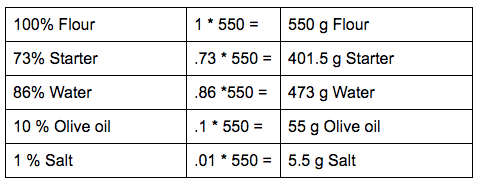
B. Pain Au Levain with 27 oz White Flour

C. Olive Tartine with 800g Total Flour
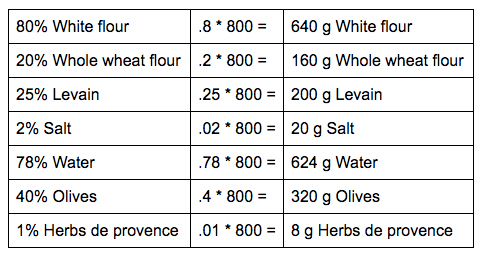
2. Convert each recipe to baker’s math
A. Cranberry Walnut Boule
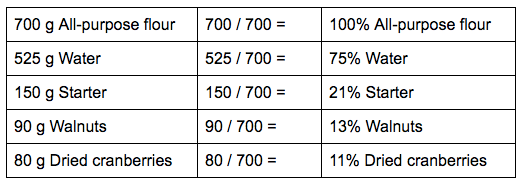
B. Bagels
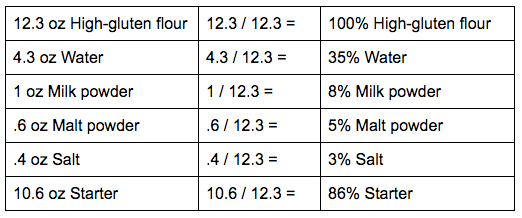
C. Pizza
In this problem, there are two flours. Simple add them together to find the total flour mass.
285 g White flour + 32 g Whole wheat flour = 317 g Total flour

3. How much of each ingredient would you use to make:
A. 900 of dough
In this problem, we’re given the total amount of dough, not the total amount of flour. I think that the easiest way to tackle this problem is to start by figuring out how much total flour we’ll need. We have other ingredients that also make up the “total percentage,” so let’s see what the sum of all the ingredient percentages are:
Total percentage = 100% + 86% + 2% + 14% = 202%
I find 202% to be a really weird way to think, so I like to think of each percentage point as a little box that holds the same weight as the 201 other boxes. Here, 900 g of dough fit into 202 little boxes. That means each box holds 4.46 g:
900 g of dough / 202 boxes = 4.46 grams per box
If the total flour fits in 100 of those boxes, we know that there are 446 g of flour:
100 boxes * 4.46 grams per box = 446 grams of total flour
Or to simplify, if we know the total amount of dough we want and have the total percentage, divide the total dough mass by the total percentages to find out the flour mass:
900 g of dough / 202% = 446 g of flour
Now all we have to do is plug 446 g of flour into the chart to solve the rest.

If you want, you can add up all the weights as the end to check your math.
223 + 116 + 107 + 384 + 9 + 62 = 900 g of dough
B. 1050 g of dough
Add up all the ingredient percentages to find the total number of “boxes”:
83% + 17% + 22% + 79% + 3% + 16% = 220%
Divide the total dough mass by the number of boxes to find out how much mass each box holds:
1050 grams of dough / 220 boxes = 4.77 grams per box
Solve for the total flour by multiplying the 100 total flour boxes by the 4.77 grams per box:
100 boxes of flour * 4.77 grams per box = 477 grams of Total flour
Or simply divide the total dough mass by the total percentages to find out the flour mass:
1050 g of dough / 220% = 447 g of flour
Plug the flour weight into the box below and solve:
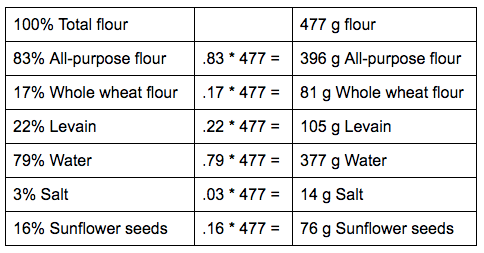
Check the math by adding up all the weights to ensure that they add up to 1050.
396 + 81 + 105 + 377 + 14 + 76 = 1049
Close enough when you account for rounding!
4. How much dough can you make with the following restricted ingredients? How much of each ingredient would you use?
A. You only have 30g of Milk left in your fridge
Just like last time, we’re going to start by looking at the total percentages.
70% + 30% + 17% + 40% + 20% + 2% = 179%
Again, let’s think about this abysmal percentage as 179 little boxes that fit our ball of dough. How much does each box hold? Well, we’re not sure yet.
What we do know is that we have 30 g of milk. If milk fit into 20 of the boxes, how much does each box hold?
30 grams of milk / 20 boxes = 1.5 grams per box
Now that we know that each box holds 1.5 grams, we can calculate the total dough we can make.
1.5 grams per box * 179 boxes = 268.5 grams of dough
We handle the rest of the problem the exact same way as problem 3. If each box holds 1.5 g and there are 100 total boxes of flour, there are 150 g of total flour.
1.5 grams per box * 100 boxes of total flour = 150 grams of total flour
Again, all we have to do is plug that number into the chart and the rest is easy to solve.

We can check our math by adding up all the weights at the end.
105 + 30 + +15 + 25.5 + 60 + 30 + 3 = 268.5
B. You only have 50g of poppy seeds left but want to make this everything bagel bread
Add up all the ingredient percentages to find the total number of “boxes”:
100% + 23% + 76% + 10% + 15% + 5% + 4% + 3% = 236%
Calculate how much each box can hold by dividing 50 g of poppy seeds by the 10 boxes it fits into:
50 grams of poppy seeds/ 10 boxes = 5 grams per box
Now that we know that each box holds 5 grams, we can calculate the total dough we can make:
5 grams per box * 236 boxes = 1180 grams of dough
Solve for the flour by multiplying the 100 total flour boxes by the 5 grams per box:
100 boxes of flour * 5 grams per box = 500 grams of flour
Plug the flour weight into the box below and solve:
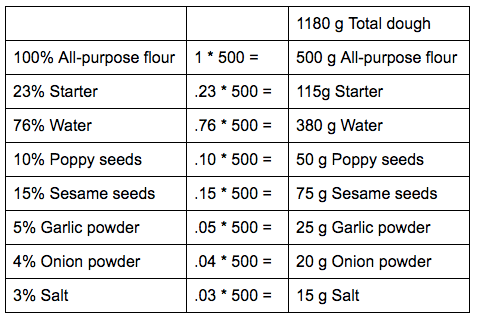
Again, we can check the math by adding up all the weights at the end:
500 + 115 + 380 + 50 + 75 + 25 + 20 + 15 = 1180

is there available book on this?
LikeLike
I so appreciate your resource! :)
That being said, I feel like problem 3 is incomplete/incorrect.
3A. you simply put 446g bread flour, when there are 3 types of flour to make the 100% so whole wheat flour should be 223g, bread flour should be 116, and AP flour should be 107g, (which do add up to 446).
My multiplier for 3B. was 4.78 which, when multiplied by 100% is 478, not 477. Slight difference that still adds up, but using either mulitiplier results in salt being 12g instead of 14g.
LikeLike
So glad you like it!
For 3A, I don’t see where you’re seeing 3 types of flour! It just says
“A. 900 of dough
100% Bread flour
86% Water
2% Salt
14% Levain”
Please let me know if I’m missing something =)
For 3B, I totally see where you’re coming from. I rounded the percentage up to 220% instead of 219.5% percent because as long as we’re using the same multiplier, the proportions of ingredients will all remain constant. I guess the downside to my way is that I end up with 1049 g instead of 1050 g of dough, so we’re cheating our customers by a g!
LikeLike